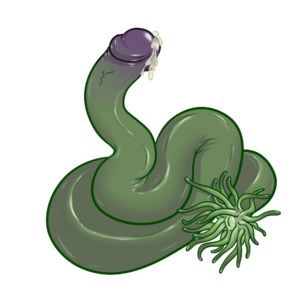Cockvine Seedling
Cockvine Seedling
| Cockvine Seedling | |
|---|---|
 Cockvine Seedling bust, by Adjatha | |
| Creator | Nonesuch |
| Information | |
| Species |
Cockvine (Hydrus Constuprula) |
| Gender | N/A |
| Location | Myrellion |
Description
Cockvine seedlings are found in the deep caverns on Myrellion.
Hydrus Constuprula, better known by its colloquial name Cockvine, is a mobile, parasitic, invasive, troglophile plant species native to Myrellion. It is endemic to large parts of the Myrellion underground, a status acknowledged by both sides of the on-going Myr conflict to be a result of its historical use as a biological weapon. A Class A non-sentient species, it is illegal for it to be transported or for individuals seeded by it to travel outside Myrellion.
Appearance
An organic, tubular something, about two feet long.
History/Personality/Information of Note
Growth Cycles and Physiology
At “birth” cockvine seedlings resemble short, thick, green snakes with a grasping, anemone-like hand at one end and a slit, blunt purple head of variable shape at the other. The hand end is remarkable for its stem cell-like versatility – whilst it functions primarily as a catcher and mouth for the cockvine seedling, it not only acts as the beginning of its root system once it enters adulthood but it can also be used to actively splice itself not just to other cockvines but to animal life as well.
Aside from the rings of flexible, fibrous muscle that they retain throughout their lives, cockvines are seeded with a huge reserve of fructose-based energy which allows them to move swiftly away from their place of origin. During this stage of their life cockvines show a snake-like aversion to large sapient creatures, actively avoiding them except in certain circumstances (see parasitism below). They do however have a ravenous attitude towards life of a similar size to it and during this, their most mobile period of existence, hunt and eat as much food as they can in preparation for the dramatic growth stages ahead. Cockvine seedlings are omnivorous and will consume almost anything, cited as a key reason for its over-reaching success on Myrellion.
Like most herbaceous life cockvines react to light and moisture and, once an infant cockvine has consumed enough, it will seek out a dark, moist place to germinate. They are particularly fond of deep, narrow crevices, as these are ideal for the purposes of their adult selves. Here the cockvine buries its hand end into the earth and proceeds to branch out a considerable root system. The stem of the plant thickens and then sprouts thick vines, similar in appearance to its infant state but far longer and stronger. Large, successfully rooted cockvines have the ability to attract less fortunate infants; these may choose to graft themselves symbiotically to it in order to provide one more tentacle to the alpha cockvine, thus increasing the overall chances of the creature successfully snagging prey. An adult cockvine can have as many as twenty appendages, each up to thirteen feet in length.
Parasitism
Because of the specificity of location the seedlings need in order to germinate it is not at all possible for every individual cockvine to find an ideal place or stockpile enough energy to enter adulthood. The species has found a striking way of surmounting this difficulty, thanks to its hand end’s ability to bind itself not just to adult cockvines but to other creatures as well.
The process occurs when a cockvine seedling has gone beyond the stage where it can successfully root itself, or otherwise senses it is better off attempting to graft itself to a more successful life-form. Cockvines acting in this way usually seek out alphas of their species to bind themselves to, however they are perfectly capable of achieving union with any creature both large enough to support them and either willing to do so or too slow to prevent it. In either case the grafted cockvine couples with the host’s nervous system and surrenders most of its own control to the host, with the larger creature able to feel and use the parasite as their own appendage. The cockvine does however retain its semen sacs and instinct to breed, and is occasionally able to overwhelm its host with a desire to use it, allowing it the opportunity to propagate its seed over a far wider range than it otherwise could. Cockvine parasitism has also been reported as a consequence of mating with an adult specimen.
Interactions
When encountered, cockvine seedlings have a randomized chance of interacting with Captain Steele, with the odds variance based on Reflexes. If Steele encounters a cockvine seedling, a couple options are available:
- Ignore - Do not interact with the cockvine seedling and ignore it.
- Chase - Try to chase the cockvine seedling.
If chosen, chasing a cockvine seedling will randomly result in success or failure depending on Reflexes. If failure to chase the seedling, Steele will stumble and lose a small amount (5%) of HP. If successful, Steele will take a closer look at it, with a possibility of 5 different variants, and Steele will have the following options:
- Kill It - Kill the creature, gaining 10 XP.
- Join - Try to attach the cockvine seedling as a tail.
- Leave - Do not interact with the cockvine seedling and ignore it, gaining 10 XP.
Transformation
When choosing to Join, Steele will undergo an immediate and permanent transformation:
| Condition | Change |
|---|---|
|
|
|
|
Removal
Currently, cockvine can only be removed by doctor facilities.
- V-Ko can remove attached cockvine after the 'Examination' and choosing 'Treat C.Vne' from her menu.
- Dr. Lash can remove attached cockvine after undergoing any of his 'Services'.
Quests
Cockvine seedlings have no related quests so far.